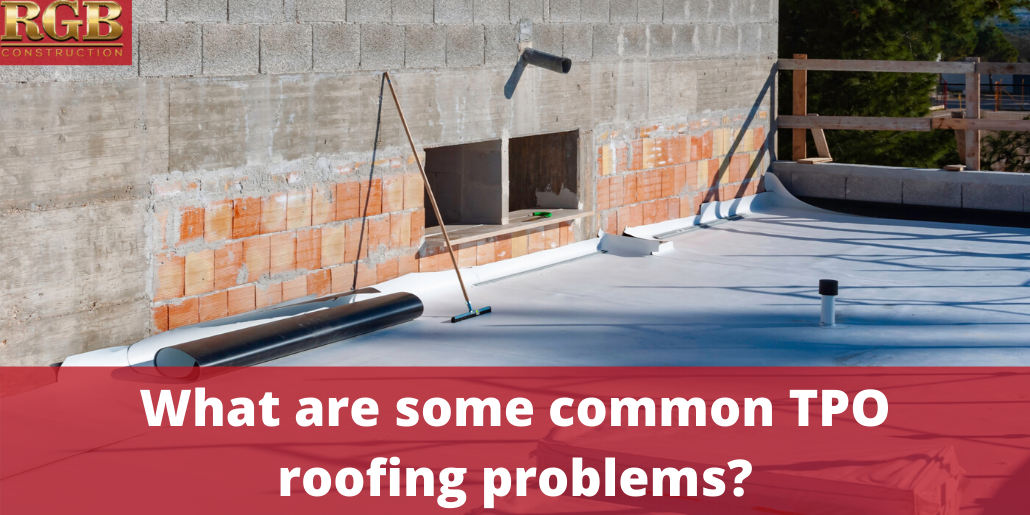There are many kinds of roofing materials out there for low-slope roofing. One type is a single-ply membrane, also known as Thermoplastic Polyolefin (TPO), the competitor of Ethylene Propylene Diene Terpolymer (EPDM). Currently, because of high-efficiency ratings, TPO is gaining popularity as a commercial roofing system. But in spite of this claim, what are some common TPO roofing problems?
What is TPO?
As mentioned earlier, TPO stands for “thermoplastic polyolefin,” which is a material that was made to serve as pond lining but has been extensively utilized for low-slope roofing since 1989. TPO is a single-ply membrane constructed with a combination of polymerized ethylene-propylene and polypropylene rubber that covers a roof using mechanical or adhesive fasteners.
TPO has two major benefits: cost and efficiency. It is a budget-friendly option, since it is easy enough to install and maintain. Since it is usually a reflective white color, it is also energy efficient and does well in sunny climates.
Installation Process
Before getting into the issues with TPO roofing, you should know how it is installed, since that is a factor in common problems. Roofers generally use two forms of adhering TPO to a commercial roof. The first method is mechanical fasteners, such as screws and washers. The other option is a water- or solvent-based adhesive.
TPO doesn’t provide a lot of insulation when applied by itself, so you can also have rigid foam insulation included. This, too, is applied with either screws or adhesive. Prior to installing the membrane, a slipsheet—a low friction barrier—is added to help the roofing contract and expand throughout the year.
Roofers also utilize overlapping strips and seals, since the seams of the TPO membrane are the most susceptible to leaks. Without this series of overlapped edges and sealed seams, you will most certainly experience water damage.
The seams are welded together with heat. A commercial roofer will often use a special welder for larger commercial rooftops, but smaller areas just need a hand-held welder. Another option is peel-and-stick tape and primer to seal the seams.
Common Problems With TPO
Now that you know a little more about TPO roofing systems, the reasons behind the common problems with TPO are going to be more understandable. Let’s have a look:
Punctured Membrane
Out of all the issues a single-ply membrane could have, this one is probably the most frequent. TPO is lightweight and flexible, but that is also its biggest disadvantage. Why? Because the membrane can be punctured. Commercial roofs experience more foot traffic than those with steeper slopes, and that can start to wear down the durability of the membrane. Furthermore, TPO lacks a hard-top layer to shield it from gravel, tools, and other gear. Impacts often cause tearing, ripping, and holes.
If you want to ward off this problem, then you need to use a primer and add layers of insulation. That will keep your roof safe, even if the membrane gets punctured.
Sun-Damaged Adhesives
Similar to above, TPO is said to be energy-efficient, but it cannot withstand the heat for too long. This isn’t surprising—roofs endure 24 hours of sunlight, 7 days a week sometimes. However, this constant exposure to intense heat will eventually damage your roofing. When this happens to TPO, degradation first begins with the adhesives.
The adhesives binding the membrane to the substrate beneath will weak, allow space to form. Additionally, the seals on the overlapped seams that create the waterproof barrier will begin to fail. If you don’t have seals, your roof is not protected.
Lack of Longevity
After the first two points, you may be questioning TPO’s resilience. Don’t worry. TPO is, without a doubt, durable. Yet, in attempts to find a commercial roofing system that is both affordable and durable, the balance of quality is still far from perfect. Improvements are being made all the time, so you can expect greater things from single-ply roofing membranes in the future.
As long as you keep up with routine maintenance and patch up punctures when they occur, you can prevent premature failure.
Installation Mistakes
TPO is available in sheets that are around 6 feet wide and about 0.05 inches thick, or in 12-foot sheets that are just a little thicker. Some are available in rolls that are unfurled on the roof. As you know, the seams are then overlapped and welded together, so that the membrane becomes watertight. Unfortunately, this does not always work.
Installation must always be done by professionals or under the supervision of an expert. If the TPO membrane has not been installed properly, the chances of the other common problems with TPO occurring are increased. To avoid such mistakes, hire a roofing contractor.
Get The Warranty
Whenever you get a new roofing system installed, you should always invest a little extra on the warranty. Warranties for TPO roofing systems can last up to 30 years. Be sure to perform routine maintenance. However, as soon as you notice a tear or any malfunction or defect with the roofing system, you should use that warranty to ensure that repairs are accomplished quickly.
Since TPO does have common problems, you will want to protect yourself from them as much as you can.
Final Thoughts on TPO
TPO is a popular single-ply membrane from low-slope rooftops. Many commercial buildings have TPO on their roofs right now. TPO does have common problems, though. Fortunately, such problems have easy solutions. As long as you are aware of what can occur in the future, you can prepare for it now. That way, if you do encounter a common problem with TPO, you can fix it immediately.
Ready to find a roofer to inspect and maintain your TPO roof? If you have any questions about TPO, fill out the contact form. We will be in touch.







